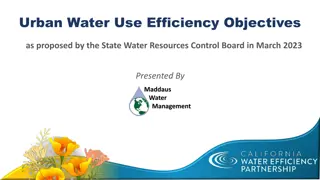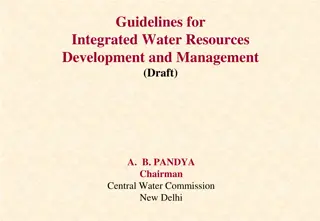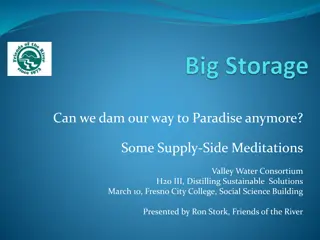Hydrogeology and Water Resource Management Problems
The content contains four challenging problems related to hydrogeology, evaporation, watershed hydrology, and flood control reservoir operations. It covers topics such as water table rise, evaporation rate calculation, unit hydrograph analysis, detention basin filling, and reservoir inflow routing. Each problem requires applying knowledge of hydrologic principles and calculations to provide solutions, making it a comprehensive set of exercises for students or professionals in the field of hydrogeology and water resource management.
Download Presentation

Please find below an Image/Link to download the presentation.
The content on the website is provided AS IS for your information and personal use only. It may not be sold, licensed, or shared on other websites without obtaining consent from the author.If you encounter any issues during the download, it is possible that the publisher has removed the file from their server.
You are allowed to download the files provided on this website for personal or commercial use, subject to the condition that they are used lawfully. All files are the property of their respective owners.
The content on the website is provided AS IS for your information and personal use only. It may not be sold, licensed, or shared on other websites without obtaining consent from the author.
E N D
Presentation Transcript
Review Question 1.Consider an unconfined aquifer overlying impermeable bedrock with the following properties Porosity 27% Specific retention 12% Thickness 15 m Hydraulic conductivity 12 m/day a) Assume that there is 2 cm of precipitation that all infiltrates and percolates to the water table, calculate the water level rise (m). b) How much water can be produced by lowering the water table by 2 m over an area of 1 km2. Report your result in m3. [10] [10] [20 points]
2. For a particular location the average net radiation is 145 W/m2, air temperature is 24 C, relative humidity is 65%, the wind speed is 1.5 m/s at a height of 2 m, and the roughness height zo is 0.02 cm. a) Determine the open water evaporation rate using the combined method (mm/d). b) Determine the fraction of net radiation that is used in evaporation. [10] [5] c) Explain what happens to the energy from net radiation that is not used in evaporation. [5] [20 points]
3.A watershed draining into a flood detention reservoir has the following 30 min unit hydrograph Time (min) 0 30 30 min UH (m3/s/cm) 0 4.5 11.5 Infiltration may be calculated using the index method with =1.5 cm/h. The flood detention basin has a volume of 60,000 m3 and the design is such that there is no outflow until this volume is reached, and any inflow volume in excess of this amount spills and becomes outflow. The detention basin is initially empty and there is no baseflow from this watershed. Consider the following storm Time 0-30 min Rainfall 0.5 cm Determine the following a)Excess precipitation in each time interval. b)The volume of the inflow into the detention basin. c)Determine whether the detention basin fills. d)If the detention basin fills determine the volume of the outflow. If the detention basin does not fill, determine the remaining unfilled volume. 60 90 8 120 2.5 150 0 30-60 min 2 cm 60-90 min 1 cm [6] [6] [4] [4] [20 points]
4.The storage capacity and stage-outflow relationship of a flood control reservoir are given by the following table. Stage (m) Storage (m3) Discharge (m3/s) You may use linear interpolation to determine storage and discharge quantities between these values. 5.0 0 0 5.5 7200 1 6 14400 7 Following is inflow to this reservoir from a storm Time (hr) 0 Inflow (m3/s) 0 Inflows should be assumed to vary linearly between these times. The initial reservoir stage is 5.0 m. a)Calculate the volume (in m3) of the inflow hydrograph. b)Route the inflow hydrograph through the reservoir using 1 hour time steps. Continue your calculations for a sufficient number of time steps to identify the peak discharge rate and report this peak discharge rate. 1 3 2 5.2 3 0 [6] [14] [20 points]























